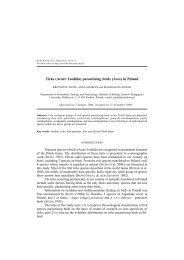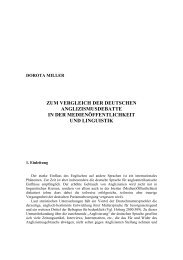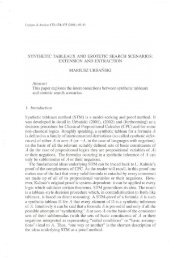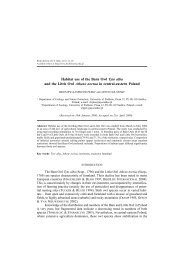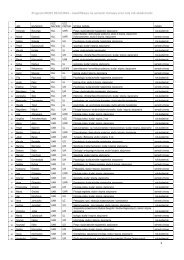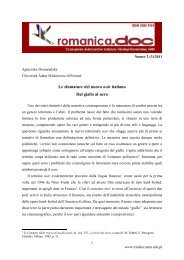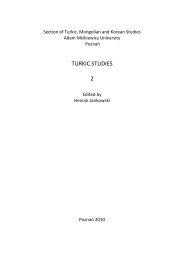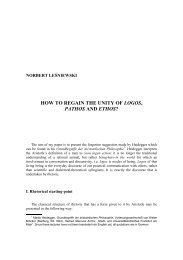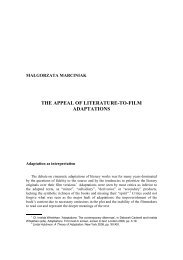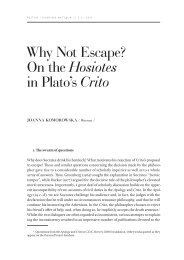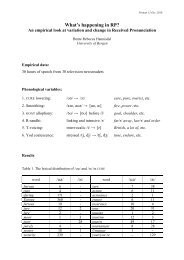Tarsonemid mites on ornamental plants in Poland: new data and an ...
Tarsonemid mites on ornamental plants in Poland: new data and an ...
Tarsonemid mites on ornamental plants in Poland: new data and an ...
Create successful ePaper yourself
Turn your PDF publications into a flip-book with our unique Google optimized e-Paper software.
TARSONEMID MITES ON ORNAMENTAL PLANTS343AFig. 2. Phyt<strong>on</strong>emus pallidus fragariae: A – male; B – femaleBABFig. 3. Polyphagotars<strong>on</strong>emus latus: A – male; B – female
344 Gabriel £ab<strong>an</strong>owski <strong><strong>an</strong>d</strong> Gra¿yna SoikaABFig. 4. Steneotars<strong>on</strong>emus laticeps: A – male; B – female<strong>Pol<strong><strong>an</strong>d</strong></strong> this mite was discovered for the first time <strong>in</strong> the Bot<strong>an</strong>ical Garden <strong>in</strong> Pows<strong>in</strong>near Warsaw (SOIKA et al., 2004). Serious damage was observed <strong>on</strong> Aster dumosuscv. Peter Harris<strong>on</strong>, N<strong>an</strong>cy, Mount Everest (4 May’00) <strong><strong>an</strong>d</strong> <strong>on</strong> Aster novi-belgiii cv.Climax, Blue Eyes, Countess of Dudlet, N<strong>an</strong>cy Ballard (19 Oct’01). This mite feedsby suck<strong>in</strong>g sap <strong>in</strong>side develop<strong>in</strong>g flower buds <strong><strong>an</strong>d</strong> shoot tips <strong>on</strong> unfold<strong>in</strong>g leaflets oflate summer-flower<strong>in</strong>g perennial asters, except Aster novae-<strong>an</strong>gliae <strong><strong>an</strong>d</strong> A. amellus,which are more resist<strong>an</strong>t. The most obvious symptom of pest occurrence is poor flower<strong>in</strong>g;m<strong>an</strong>y blooms are c<strong>on</strong>verted <strong>in</strong>to rosettes of small leaves due to the <str<strong>on</strong>g>mites</str<strong>on</strong>g>’feed<strong>in</strong>g with<strong>in</strong> the develop<strong>in</strong>g buds. Infested <strong>pl<strong>an</strong>ts</strong> are also stunted <strong><strong>an</strong>d</strong> have brownishscarr<strong>in</strong>g <strong>on</strong> the stems.Polyphagotars<strong>on</strong>emus latus (B<strong>an</strong>ks, 1904) – broad mite. It is polyphagous <strong>on</strong>a wide assortment of <strong>ornamental</strong>s <strong><strong>an</strong>d</strong> some vegetable crops under covers. Forexample, <strong>in</strong> C<strong>on</strong>necticut (USA) it has a wide host r<strong>an</strong>ge <strong><strong>an</strong>d</strong> c<strong>an</strong> feed <strong>on</strong> Afric<strong>an</strong>violets, ageratums, beg<strong>on</strong>ias, cyclamens, dahlias, gerberas, glox<strong>in</strong>ias, hibiscus, ivy,jasm<strong>in</strong>e, impatiens, New Gu<strong>in</strong>ea impatiens, l<strong>an</strong>t<strong>an</strong>as, marigolds (Tagetes spp.), snapdrag<strong>on</strong>s,verbenas <strong><strong>an</strong>d</strong> z<strong>in</strong>nias (PUNDT 2005). Some more <strong>ornamental</strong> host specieswere found by DENMARK (2000): Aphel<strong><strong>an</strong>d</strong>ra sp., Cissus discolor, C. rotundifolia,Codiaeum variegatum, Fatsia jap<strong>on</strong>ica, Hoya carnosa, Pelarg<strong>on</strong>ium sp., Peperomiasp., Plectr<strong>an</strong>thus australis, Schefflera arboricola. In <strong>Pol<strong><strong>an</strong>d</strong></strong> it has become comm<strong>on</strong>s<strong>in</strong>ce 1982, when it was imported from the Netherl<strong><strong>an</strong>d</strong>s <strong>on</strong> gerbera seedl<strong>in</strong>gs(£ABANOWSKI et al. 1990). Up to now, we have observed it <strong>on</strong> 16 species of <strong>pl<strong>an</strong>ts</strong>bel<strong>on</strong>g<strong>in</strong>g to 14 families (Table 1). The broad mite feeds <strong>on</strong> the <strong>new</strong>est growth, caus<strong>in</strong>gmalformati<strong>on</strong> of the term<strong>in</strong>al leaves. They are severely stunted, hardened <strong><strong>an</strong>d</strong> curldown at the edges with brownish or reddish lower surfaces, depend<strong>in</strong>g <strong>on</strong> host spe-
TARSONEMID MITES ON ORNAMENTAL PLANTS345Table 1. Records of the broad mite (Polyphagotars<strong>on</strong>emus latus) <strong>on</strong> <strong>ornamental</strong> <strong>pl<strong>an</strong>ts</strong> <strong>in</strong> commercialglasshouses <strong>in</strong> <strong>Pol<strong><strong>an</strong>d</strong></strong>Pl<strong>an</strong>t family <strong><strong>an</strong>d</strong> speciesAc<strong>an</strong>thaceaeAphel<strong><strong>an</strong>d</strong>ra squarosaAmar<strong>an</strong>thaceaeCelosia cristataAraceaeAnthurium x hortul<strong>an</strong>umAraliaceaeFatshedera x lizeiHedera helixSchefflera arboricolaAsteraceaeGerbera james<strong>on</strong>iiBalsam<strong>in</strong>aceaeImpatiens novigu<strong>in</strong>eaBeg<strong>on</strong>iaceaeBeg<strong>on</strong>ia elatiorBign<strong>on</strong>iaceaeRadermachera s<strong>in</strong>icaGesneriaceaeSa<strong>in</strong>paulia i<strong>on</strong><strong>an</strong>thaNyctag<strong>in</strong>aceaeBouga<strong>in</strong>villea sp.PiperaceaePeperomia magnoliaeofoliaPrimulaceaeCyclamen persicumSol<strong>an</strong>aceaeSol<strong>an</strong>um capsicastrumVitaceaeCissus <strong>an</strong>tarcticaLocality <strong><strong>an</strong>d</strong> date£ódŸ, 27 Sep’00Kraków, 11 Jun’99Nowy Dwór Mazowiecki, 15 Mar’99Wieliszew near Nowy Dwór Mazowiecki, 7 Oct’97;Mys³owice near Katowice, 30 Nov’90; Pabi<strong>an</strong>ice, 6 Oct’90;Skierniewice, 3 Feb’93, 11 Oct’2005; Wieliszew, 7 Oct’97Ró¿<strong>an</strong>ki near Gorzów, 6 Oct’90; Pruh<strong>on</strong>ice near Praha,23 Jun’87Czêstochowa, 28 Sep’85; Ka³uszyn near Siedlce, 5 Aug’91;Kraków, 8 Aug’00; £ódŸ, 17 Apr’85; 13 J<strong>an</strong>’97, 28 Oct’88;Pabi<strong>an</strong>ice near £ódŸ, 26 Sep’91; Skierniewice, 26 Jun’94;16 Sep’05Opole, 5 Jul’04; Warsaw, 10 Apr’06Kraków, 11 Jun’99; £ódŸ, 27 Aug’00; Skierniewice,9 Oct’01, 13 Sep’05; Wola Warszawska, 18 May’03Skierniewice, 28 Nov’97; Wieliszew near Nowy DwórMazowiecki, 28 Aug’97; Wola Warszawska, 11 Jul’98Wola Warszawska, 18 May’03Skierniewice, 21 Oct’05Skierniewice, 29 Oct’01Skierniewice, 6 Dec’01Wieliszew near Nowy Dwór Mazowiecki, 7 Oct’97Mys³owice near Katowice, 30 Nov’90cies. The body of males (Fig. 3A) is oval, 168 :m l<strong>on</strong>g, broadest at mid-length(97 :m), prodorsum with 3–4 pairs of dorsal setae (DENMARK 2000).Steneotars<strong>on</strong>emus laticeps (Halbert, 1923) – bulb scale mite. It is oligophagous<strong>on</strong> <strong>pl<strong>an</strong>ts</strong> of the family Amaryllidaceae. In Brita<strong>in</strong> it is a pest of narcissus bulbs,which causes brown scars <strong>on</strong> <strong>on</strong>e or more of the bulb scales <strong>in</strong> the neck regi<strong>on</strong> <strong>in</strong>
346 Gabriel £ab<strong>an</strong>owski <strong><strong>an</strong>d</strong> Gra¿yna Soikathe dorm<strong>an</strong>t period, it deforms leaves (giv<strong>in</strong>g a “saw-edge” effect) <strong><strong>an</strong>d</strong> reduces thequality of flowers (LANE 1979). In <strong>Pol<strong><strong>an</strong>d</strong></strong> it was found for the first time <strong>on</strong> Hippeastrumsp. <strong>on</strong> 14 Mar’84 (£ABANOWSKI et al. 1990) <strong><strong>an</strong>d</strong> it was sampled from narcissusbulbs imported from the Netherl<strong><strong>an</strong>d</strong>s, the United K<strong>in</strong>gdom <strong><strong>an</strong>d</strong> Germ<strong>an</strong>y(KARNKOWSKI 1995). Up to now we also have observed the damage <strong>on</strong> Eucharis sp.<strong><strong>an</strong>d</strong> Narcissus sp. imported from the Netherl<strong><strong>an</strong>d</strong>s. The males (Fig. 4A) have 4 pairsof prodorsal setae; femur IV does not have <strong>an</strong>y fl<strong>an</strong>ge-like process <strong>on</strong> the <strong>in</strong>ner marg<strong>in</strong>;the tactile seta <strong>on</strong> tibia IV is short <strong><strong>an</strong>d</strong> not as l<strong>on</strong>g as the femoral segment. Thegnathosoma is subcircular <strong><strong>an</strong>d</strong> the third pair of prodorsal setae are 2/3 as l<strong>on</strong>g as thewidth of the gnathosoma. The body of females is el<strong>on</strong>gate, legs I <strong><strong>an</strong>d</strong> II are widelyseparated from legs III <strong><strong>an</strong>d</strong> IV. There are 2 pairs of prodorsal hair-like setae (JEPP-SON et al. 1975).CONCLUSIONS1. On <strong>ornamental</strong> <strong>pl<strong>an</strong>ts</strong> <strong>in</strong> glasshouses, we recorded 3 species of tars<strong>on</strong>emid<str<strong>on</strong>g>mites</str<strong>on</strong>g> as pests: Polyphagotars<strong>on</strong>emus latus, very comm<strong>on</strong> <strong>on</strong> m<strong>an</strong>y cut flowers <strong><strong>an</strong>d</strong>potted <strong>pl<strong>an</strong>ts</strong>; Phyt<strong>on</strong>emus pallidus pallidus, very rare <strong>on</strong> azaleas <strong><strong>an</strong>d</strong> chrys<strong>an</strong>themum,not found <strong>on</strong> cyclamens; <strong><strong>an</strong>d</strong> Steneotars<strong>on</strong>emus laticeps, associated withamaryllidaceous <strong>pl<strong>an</strong>ts</strong>, ma<strong>in</strong>ly Hippeastrum spp.2. Phyt<strong>on</strong>emus pallidus asteris causes serious damage <strong>in</strong> the field <strong>on</strong> late summer-flower<strong>in</strong>gperennial asters: Aster dumosus <strong><strong>an</strong>d</strong> A. novi-belgii.Acknowledgments: We th<strong>an</strong>k Dr WOJCIECH MAGOWSKI, A. Mickiewicz University, Poznañ, foridentificati<strong>on</strong> of Phyt<strong>on</strong>emus pallidus asteris.REFERENCESDENMARK H. A. 2000. Broad mite, Polyphagotars<strong>on</strong>emus latus (B<strong>an</strong>ks) (Arachnida: Acar<strong>in</strong>a:<str<strong>on</strong>g>Tars<strong>on</strong>emid</str<strong>on</strong>g>ae). EENY-183. University of Florida. IFAS Extensi<strong>on</strong>, http://creatures.ifas.ufl.edu,3 pp.JEPPSON L. R., KEIFER H. H., BAKER E. W. 1975. Mites <strong>in</strong>jurious to ec<strong>on</strong>omic <strong>pl<strong>an</strong>ts</strong>. Ch. 10.<str<strong>on</strong>g>Tars<strong>on</strong>emid</str<strong>on</strong>g>ae Kramer. pp. 285–305, University of California Press, Berkeley.KARL VON E. 1965. Untersuchungen zur Morphologie und Ökologie v<strong>on</strong> <str<strong>on</strong>g>Tars<strong>on</strong>emid</str<strong>on</strong>g>en gärtnerischerKulturpfl<strong>an</strong>zen. I. Tars<strong>on</strong>emus pallidus B<strong>an</strong>ks. Biol. Zentralblatt. 47–80.KARNKOWSKI W. 1995. Method for exam<strong>in</strong>ati<strong>on</strong> of Narcissus bulbs to detect the bulb scale mite(Steneotars<strong>on</strong>emus laticeps Helbert) (Acar<strong>in</strong>a: <str<strong>on</strong>g>Tars<strong>on</strong>emid</str<strong>on</strong>g>ae). Proc. Symp. On “Adv<strong>an</strong>cy ofAcarology <strong>in</strong> <strong>Pol<strong><strong>an</strong>d</strong></strong>”, Siedlce, September 26–27, 1995 (BOCZEK J., IGNATOWICZ S., Eds),pp. 106–110.LANE A. 1979. Bulb scale mite. M<strong>in</strong>istry of Agriculture, Fisheries <strong><strong>an</strong>d</strong> Food. Leaflet 456, 6 pp.£ABANOWSKI G. S., £ABANOWSKA B. H., SUSKI Z. W., 1990. New species of <str<strong>on</strong>g>mites</str<strong>on</strong>g> (Acar<strong>in</strong>a) <strong>in</strong>the fauna of <strong>Pol<strong><strong>an</strong>d</strong></strong>. Zesz. Probl. Post. Nauk Rol., 373: 9–17.PUNDT L. 2005. M<strong>an</strong>ag<strong>in</strong>g cyclamen <str<strong>on</strong>g>mites</str<strong>on</strong>g> <strong><strong>an</strong>d</strong> broad <str<strong>on</strong>g>mites</str<strong>on</strong>g> <strong>in</strong> Greenhouse eith <strong>new</strong> images J<strong>an</strong>uary2005. http://www.hort.uc<strong>on</strong>n.edu/ipm/greenhs/htms/cycl<str<strong>on</strong>g>mites</str<strong>on</strong>g>.htm, 3 pp.SOIKA G., £ABANOWSKI G. S., BRZOZOWSKA-MICHALAK J. 2004. The occurrence of phytophagous<str<strong>on</strong>g>mites</str<strong>on</strong>g> <strong><strong>an</strong>d</strong> <strong>in</strong>sects <strong>on</strong> perennials <strong>in</strong> bot<strong>an</strong>ical gardens <strong><strong>an</strong>d</strong> urb<strong>an</strong> areas <strong>in</strong> <strong>Pol<strong><strong>an</strong>d</strong></strong>. In: Protecti<strong>on</strong>of pl<strong>an</strong>t collecti<strong>on</strong>s aga<strong>in</strong>st pests <strong><strong>an</strong>d</strong> diseases (WIECH K., ZEMANEK B., Eds). Vol. II, pp. 30–37, Oficyna Wydawnicza TEXT, Kraków.Associate editor: ANNA SKORACKA




